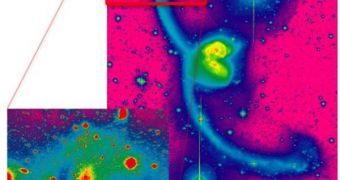While investigating the skies in search of colliding galaxies, astronomers working with the Subaru telescope, on Mauna Kea, in Hawaii, have discovered what amounts to the skid marks left behind by cars before crashing. Debris ejected by two galaxies while approaching each other and during their collision form a path that may lead experts in determining the areas they came from, and what course they followed before running into each other. The find might also shed some light on galaxy formation and starburst activity in the earlier Universe, experts announced yesterday at the 214th meeting of the American Astronomical Society, held in Pasadena, California.
“This is equivalent to finally being able to trace the skid marks on the road when investigating a car wreck,” California Institute of Technology team member Nick Scoville said, quoted by Space. He added that the formations were discovered in more than a dozen instances, including in the famous Antennae Galaxies (located some 65 million light-years away in the Constellation Corvus), Arp 220 (in the Constellation Serpens, some 250 million light-years away), and in the Mrk 231 formation (in the Big Dipper, roughly 590 million light-years away). A light-year has about ten trillion kilometers.
Some of the debris that were recently observed were found to stretch across areas of space several times larger than the Milky Way, which, by all accounts and purposes, is considered to be a massive galaxy. The finds came as a shock to observers, who said that they didn't expect such large formations not to be discovered by previous studies. Behind Mrk 231, they found a massive tidal tail following it, and they also noticed that the extension of the Antennae Galaxies was two times larger than first observed.
“Arp 220 is the most famous Ultra Luminous Infrared Galaxies (ULIRG). ULIRG are very likely the dominant mode of cosmic star formation in the early Universe, and Arp 220 is the key object to understand starburst activities in ULIRG,” Yoshiaki Taniguchi, an expert from the Ehime university in Japan and also a team member in the new study, explained. He added that tidal Tails occurred when galaxies merged at high speeds, and pieces of them were simply ripped apart by the large gravitational forces exerted on them. When this occurs, active stellar formation processes also appear.

 14 DAY TRIAL //
14 DAY TRIAL //